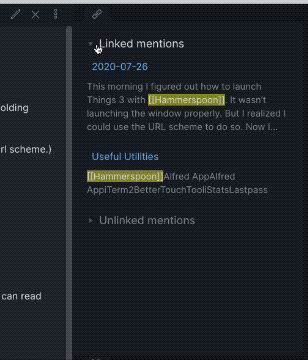I have a lot of cross-roads at links that are broad categories .
Exactly that. I wonder for myself if they would be better as hashtags or nothing at all. I’m coming to the point where anything less than 3 words (“Courses”, “Work”, “Deep Work”, “Freelancing”) will likely not become its own note and even just maybe become a hashtag.
And then “Courses” is one of those one-word links you mention, and suddenly it branches out into a dozen different topics and now I’m on a note about music production, completely derailing the thought process. It’s generic, and less helpful.
“Generic” is really good word to describe the property. Following along or passing through generic nodes is less helpful because the connections are too broad. Surprisal (Information content) gets lost [^1]. As opposed to niche or long tail I reckon.
For example, I have one note about a project I worked on. If I add a link to “work”, that’s generic, obvious and is not bringing me to a new thought-process.
On the other hand, I have a whole niche section about “Victorian-era Oil Painting”, which reminded me of two books I had read (“Hackers and Painters” by Paul Graham and “The Victorian Internet” by Tom Standage.)
When I juxtaposed those three ideas through linking, my mind was bent in a completely new direction for over a week.
Although interconnected ideas are actually one of my main topics. Randomness, entropy, mingling of ideas. This research paper “The Entropic Brain ” talks about how psychedelic drugs, for example bust open the default mode network of the brain and cause a lot of novel connections. Too much entropy, and it is meaningless chaos. Too little entropy, and you get stuck in narrow ruts of thought. (I’ll think more on this… ha!)
Oh man. That is so on-point. In fact, I’ve described Obsidian as a psychedelic discovery tool in the original sense of the word (Greek Psyche + Greek dēlos ‘clear, manifest’). That’s because it can make visible (dēlos ‘clear, manifest’) what’s otherwise hidden.
That’s why I’m relatively obsessed with the graph-view.
And yes, I think what we’re talking about here is exploring the threshold between “bursting open the default mode network” and “too much entropy, and its meaningless chaos” – The right “dosage” of backlinks 
[^1] Claude Shannon’s definition of self-information was chosen to meet several axioms:
- An event with probability 100% is perfectly unsurprising and yields no information.
- The less probable an event is, the more surprising it is and the more information it yields.
- If two independent events are measured separately, the total amount of information is the sum of the self-informations of the individual events.




